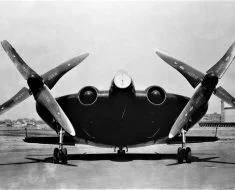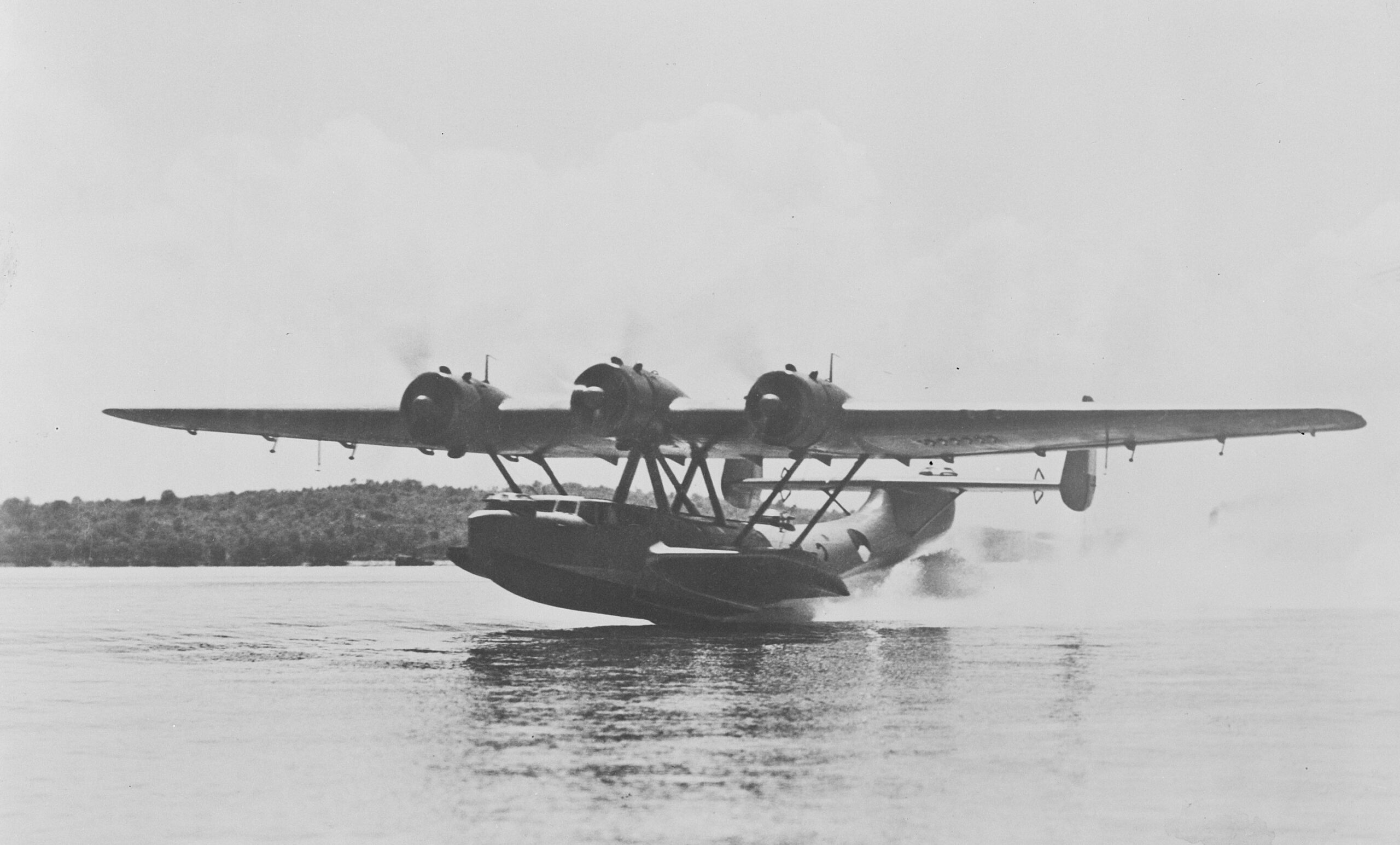The B-29 Superfortress stands as the prime example of the result of 6 years of war-driven technological innovation, an aircraft of amazing sophistication and capability that was designed from the outset to win the war in the Pacific theatre.
One of the largest aircraft of the Second World War and certainly the largest bomber, the B-29 was the first strategic weapon system ever employed.
It devastated the Japanese homelands with bombing raids in the latter part of the conflict, and finally brought the war to an end by being used to drop the first ever nuclear weapon in anger – twice!
Planning for the design and manufacture of the B-29 would end up costing the American taxpayer a hideous amount of money – the Superfortress program was the most expensive weapon project of the entire war, exceeding even that of the Manhattan Project which produced the world’s first atomic weapons.
But the end result was nevertheless impressive; a futuristic and deadly fast heavy bomber that introduced many firsts for aviation operational concepts, such as full pressurisation and computerised defensive systems.

The B-29 represents the pinnacle of combat aircraft design at the end of the war, in contrast with the often crude airframes equipping front-line squadrons in 1939 such as the Gloster Gladiator, a biplane fighter with fixed undercarriage.
By 1945 the Superfortress could fly higher and faster than most of the Japanese fighters attempting to defend their homeland from American bombing raids, and the B-29 operated with near-impunity in the skies of the Pacific theatre of operations.
Read More: Boeing B-17 – The Flying Fortress
The Superfortress had an excellent service record in two wars, and will always be immortalised as the weapon that changed the entire face of warfare after the nuclear strikes on Hiroshima and Nagasaki.
Contents
Design and development
Despite the American government’s official position of strict neutrality in the years leading up to the Second World War, the US military was still formulating plans for possible conflict, especially in the Pacific region where relations with Japan had been fraying since the early 1930s.

The United States Army Air Corps (USAAC) realised that their new B-17 Flying Fortress simply did not have the operating range to fly bombing missions in the vast expanses of the Pacific Ocean, perhaps one of the few shortcomings of this otherwise formidable heavy bomber.
These criticisms reached the ears of Boeing executives, and in response, the company began designing a new long-range bomber incorporating new technological proposals such as a fully pressurised airframe.
In December 1939 the USAAC issued a formal specification for a new multi-engine bomber. The technical requirements were formidable: the ability to carry 10 tons of bombs nearly 3,000 miles from home base at a speed of 400 mph.
Boeing adapted and modified its earlier conceptual work into a new design called the Model 345, which it formally submitted to the USAAC in May 1940.
Consolidated Aircraft, Lockheed and Douglas also submitted proposals for a heavy bomber, but only Boeing and Consolidated continued into prototyping and manufacturing after this date.
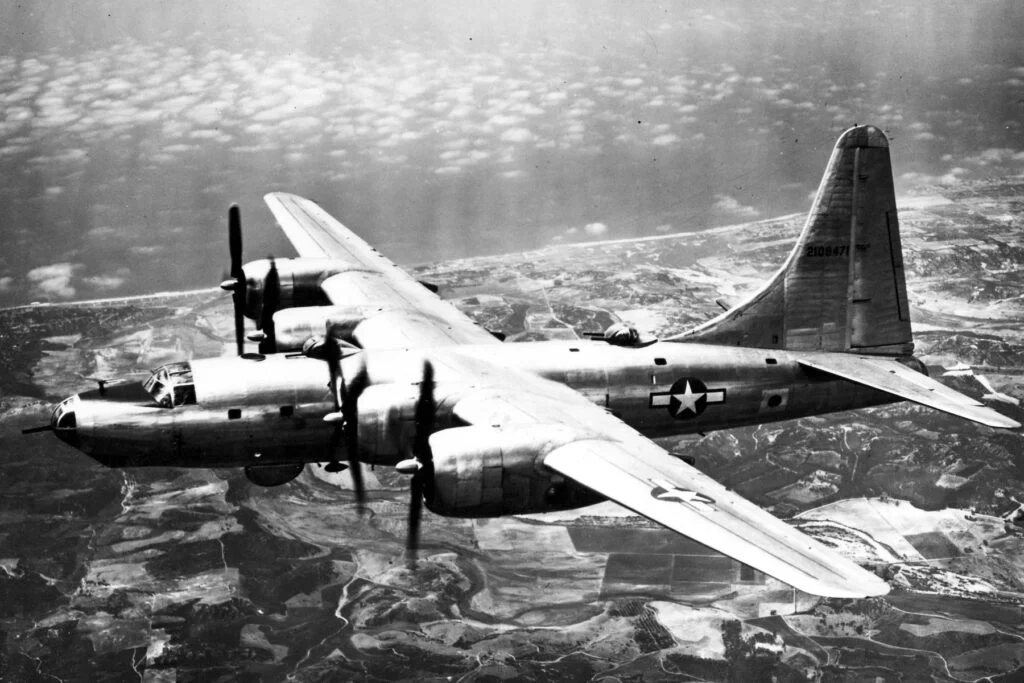
While the USAAC allowed the advancement of the Consolidated proposal into the B-32 heavy bomber as a backstop, the more promising Boeing design was selected for testing and further development.
An order for two flyable prototypes and a static test airframe was issued in August 1940, but this was changed to three flyable aircraft in December 1940.
Read More: Mig-31 Foxhound – Brutal Looks, Deadly Firepower
The first service order for 14 service test airframes and 250 production aircraft followed in May 1941, and this was increased to 500 units in January 1942, with the first flight of a prototype occurring in September 1942.
The incredible complexity of the design and pressure for wartime production led to many complications and delays, and major problems arose with the Wright Cyclone engines powering the Superfortress, which promised excellent performance but were temperamental if operated incorrectly.
Technical fixes and improvements flew thick and fast, to the point where aircraft were being flown directly from production plants direct to modification workshops for extensive work before being released for service.
Further delays and technological problems kept disrupting the production of service aircraft, and though a hundred aircraft had been delivered by the end of 1943, only 15 were airworthy. It took the personal intervention of the head of the USAAF to break the deadlock, and the first 150 combat-ready aircraft were ready for service in April 1944.
The reliability problems in the Wright Cyclone engines were gradually rectified, but the problem did not fully disappear until the fitting of new engines in the B-29 (and the following B-50 model). But this development arrived too late for service during the Second World War.
The B-29 and the later B-50 continued in service after the war and also served in the Korean War, where it was found to be vulnerable to attacks from jet fighters. The total production figures for the B-29 are recorded as 3,970 airframes of all models and configurations, during the main manufacturing runs from 1943-46.
The B-29
The Superfortress fuselage was designed with a circular cross-section for strength and rigidity, and this configuration enabled the adoption of full pressurisation for the airframe with the exception of the bomb bays.

Otherwise, it was a conventional design, with mid-mounted high-aspect wings, a conventional single-fin tailplane and a tricycle undercarriage. The design requirements demanded large dimensions, and the B-29 was a monster indeed.
The Superfortress had a height of 27 feet 9 inches (8.46 metres), a length of 99 feet (30.1 metres) and a wingspan of 141 feet 3 inches (43.05 metres). Empty, the basic airframe tipped the scales at 74,500 lbs (33,790 kg) and the gross weight was 120,000 lbs (54,430 kg). The MTOW of the B-29 was an incredible 133,500 lbs (60,555 kg).
Read More: Curtiss XP-55 Ascender – The Flawed Fighter
The crew of the Superfortress consisted of 10-11 personnel: pilot, co-pilot, bombardier, navigator, radio operator, flight engineer, left/right and tail gunners and a specialised gunnery position known as the central fire control officer, who was positioned near the front cockpit.
The B-29 was fitted with four Wright R-3350-23 Duplex Cyclone 18-cylinder air-cooled turbosupercharged radial engines equipped with four-bladed propellers 16 feet (5 metres) in diameter, which each generated 2,200 horsepower.

These powerful engines meant that the Superfortress could attain a top speed of nearly 360 mph (580 km/h), and the aircraft had a cruise speed of 220 mph (350 km/h), but the high-aspect wing design mandated a dangerously high stalling speed of 105 mph.
The B-29 had an operational combat range of 3,250 miles (5,230 kilometres) and a ferry range of an impressive 5,600 miles (9,000 kilometres). The service ceiling of the Superfortress was 31,850 feet (9,710 metres).
The B-29 was equipped with defensive gun positions that employed analogue computers to control remotely-operated gun turrets, enabling a single gunner to direct the fire of multiple gun positions.
The fire control officer shifted control of turrets to the individual gunners as required, depending on the direction of the attack by enemy fighters. The four turrets could be controlled by any of the gunners, including the tail gunner who had the only directly-controlled gun position.
Each turret had two .50 calibre M2 machine guns but four guns were sometimes carried in the upper front remote turret. The tail gun position was originally fitted with two .50 machine guns and a 20mm M2 cannon, but this was omitted in later production aircraft, and sometimes a third machine gun was fitted instead.
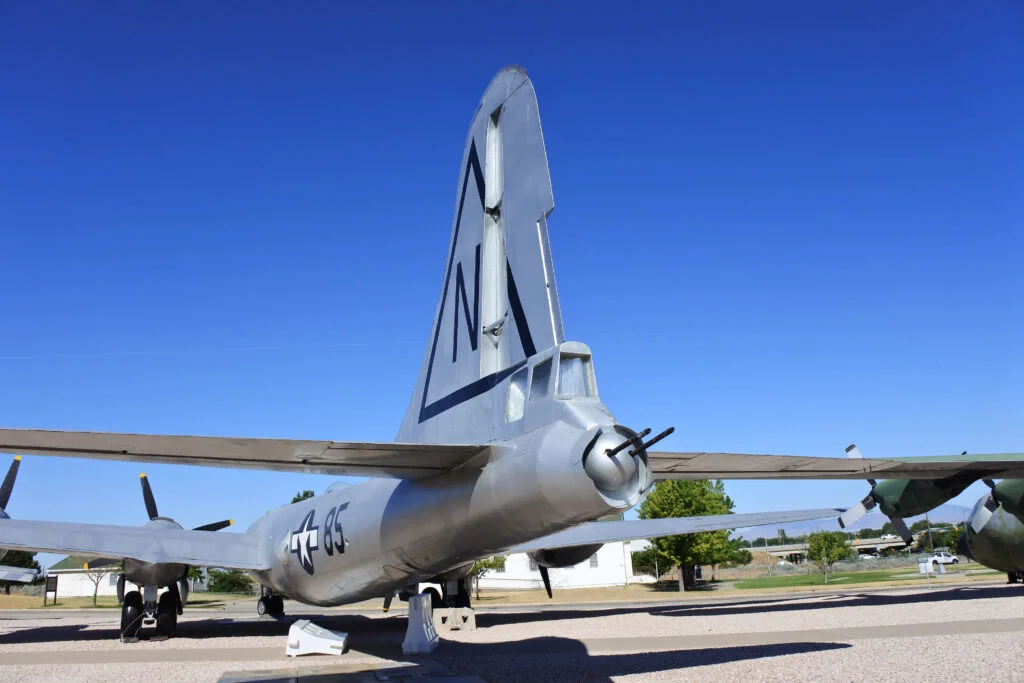
The Superfortress had a maximum bomb load of 20,000 lbs (9,100 kilograms), but early service saw this maximum load only carried over short distances at low altitudes.
For longer-range missions, lighter bomb loads were routinely employed until the platform’s engine difficulties were partially rectified. The ‘Silverplate’ aircraft specially configured for the August 1945 atomic strikes were almost completely stripped of defensive weaponry, instead having the specialised equipment fitted that was required for the nuclear weapons delivery role.
Service
The initial plan for combat use of the B-29 envisaged the aircraft prosecuting the bombing war against Germany, before shifting focus to the Pacific after victory in Europe.
Production delays and changing priorities saw the Superfortress dedicated to the war in the Pacific theatre instead, and the first groups equipped with the B-29 started to operate out of remote airfields in China and India, with the first combat mission against Japanese targets in Bangkok taking place on the 5th June 1944.
On the 15th June, an attack by 50 B-29s on steelworks in Japan was only moderately successful but was the first bombing raid on the Japanese homeland since the Doolittle Raid of 1942. Far worse was to follow.
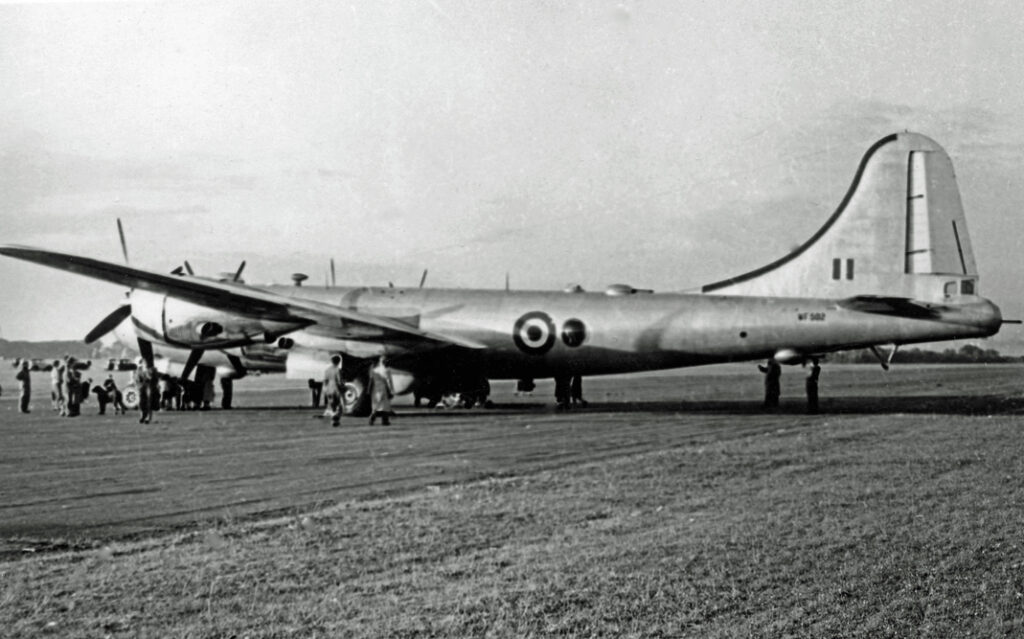
Raids from Chinese airfields gradually stepped up, despite the logistical problems and the restrictions on range that allowed only southern areas of Japan to be attacked.
The Joint Chiefs realised that the full potential of the Superfortress would be attained if an operating base closer to Japan could be found, and in December 1943 the decision was taken to seize the Mariana Islands to provide these crucial airfields.
Read More: Edgley EA-7 Optica – The Flying Eye
The US Navy and Marines invaded and secured the Marianas by August 1944, and the first airfields were being constructed even while the ground fighting continued.
The first B-29s arrived on Saipan in October 1944, and raids against Japan increased in intensity and ferocity from this date.
Operational use of the B-29 led to further innovation. When it was realised that most Japanese fighters were incapable of intercepting the Superfortress at altitude, the initial green/grey paint scheme was discontinued to save weight and cost, and the B-29 with its gleaming aluminium skin also gained a few knots of airspeed as well.
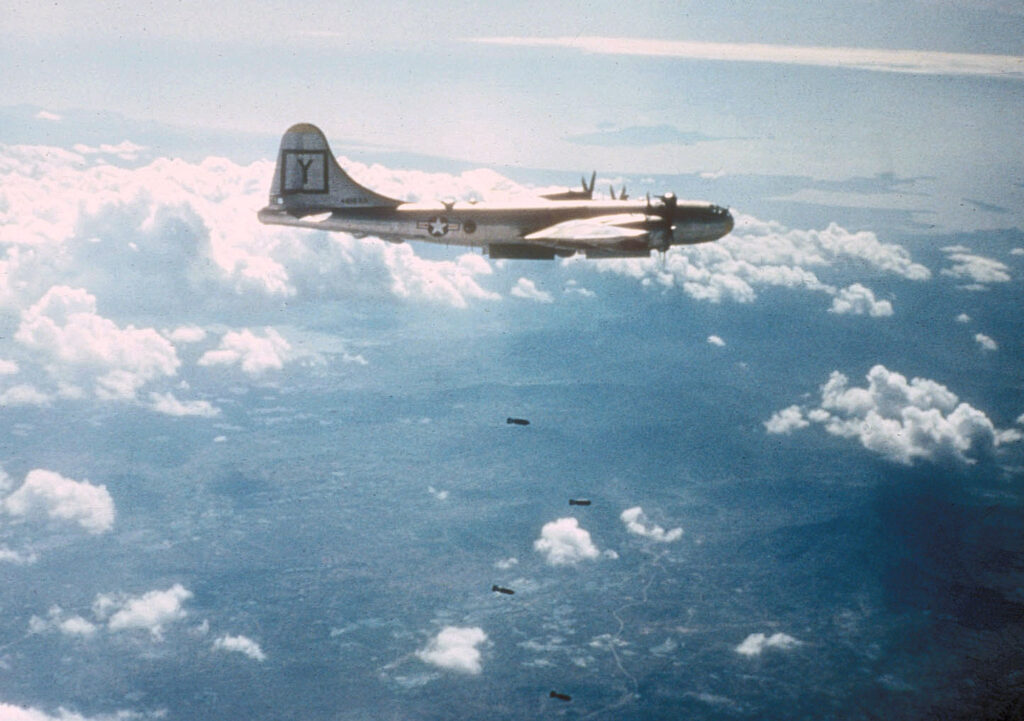
The commander of USAAF bombers in the Pacific region also ordered his crews to remove most of the defensive weaponry as it was mostly not needed on operations, and consequently greater range and an increased bombload became possible.
In 1945 operations were switched from high-level bombing with fragmentation bombs to low-level night attacks using incendiaries against Japan’s cities comprising mostly of wooden houses.
These operations enabled the Superfortress to carry its entire payload weight of 10 tons, and the results on Japanese cities were simply horrifying. These included the single most devastating bombing raid of the entire war, which occurred on the night of 9th March 1945 over Tokyo.
270 B-29s dropped their entire payload capacity of incendiaries in the east of the city, and the resulting conflagration in the mainly wooden city reduced sixteen square miles to ash and total destruction, with over 100,000 Japanese citizens killed.
Lesser known, but of equal importance to the war effort was Operation Starvation, where the B-29 was used to mine Japanese harbours and shipping routes. This caused much material shortage in Japanese military equipment manufacture and reduced their ability to deploy forces by sea.
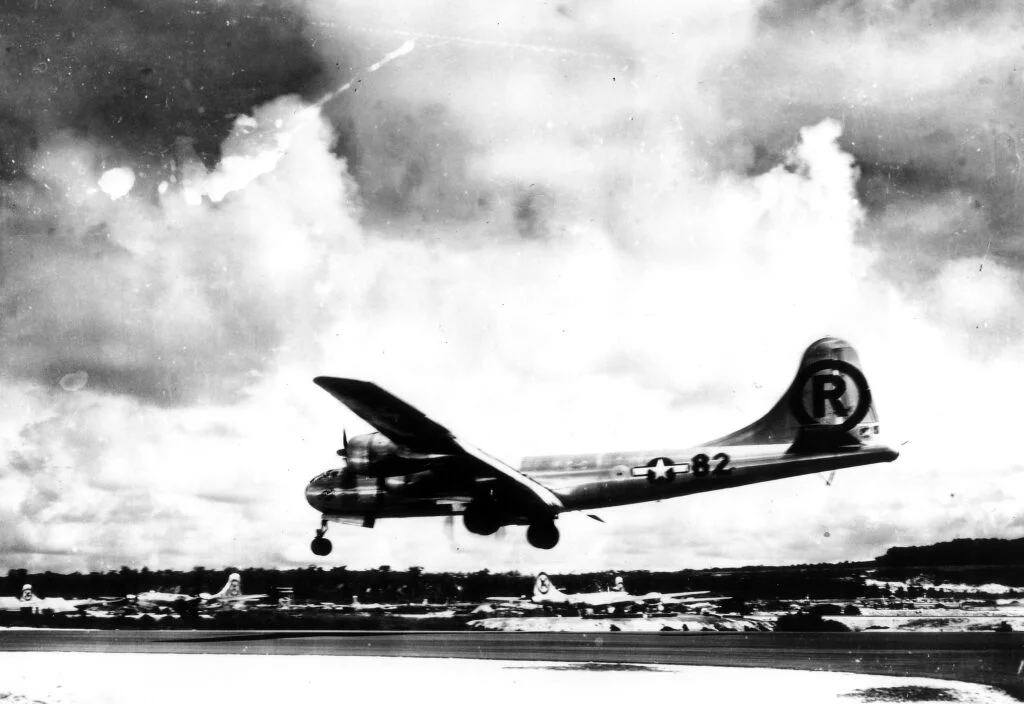
But it is the nuclear strikes on Hiroshima and Nagasaki in August 1945 that the Superfortress is best known for. These attacks are generally considered to have convinced the Japanese government to surrender before the homeland had to be invaded and subjugated, thereby saving countless lives on both sides.
The Superfortress also served in the Korean War of 1950-53 but did not fare so well against jet fighters like the MiG-15, which necessitated the need for escort fighters when on bombing missions over North Korea.
Britain also operated the B-29 as the Washington strategic bomber until 1954, and the Soviets illegally reverse-engineered interned B-29s into the Tupolev TU-4 bomber.
The B-29 and the B-50 were the first aircraft operated in the nuclear-armed Strategic Air Command (SAC), but when the gigantic B-36 Peacemaker was introduced into service the B-29 and the equally huge B-50 were reclassified as medium bombers!
Conclusion and legacy
The B-29 Superfortress has a somewhat convoluted legacy, as the aircraft is well remembered for its sterling service in two wars, but this is overshadowed by its reputation as the first aircraft ever to drop a weapon of mass destruction in wartime.
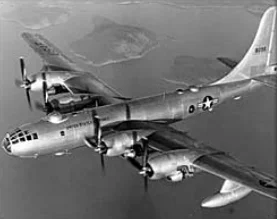
While this aspect of its service will ensure the B-29 an immortal place in the history of aerial combat, it should be also remembered for its incredible design innovation which did so much to advance the progress of aviation engineering and manufacturing processes.
Read More: Bristol 188 – Britain’s Botched SR-71
However, for most people, the mere mention of the Superfortress only brings to mind an image of a mushroom-shaped cloud, and sadly this is the most enduring memory and legacy of an otherwise fine combat aircraft.
Specifications
- Crew: 11 (Pilot, Co-pilot, Bombardier, Flight Engineer, Navigator, Radio Operator, Radar Observer, Right Gunner, Left Gunner, Central Fire Control, Tail Gunner)
- Length: 99 ft 0 in (30.18 m)
- Wingspan: 141 ft 3 in (43.05 m)
- Height: 27 ft 9 in (8.46 m)
- Empty weight: 74,500 lb (33,793 kg)
- Gross weight: 120,000 lb (54,431 kg)
- Max takeoff weight: 133,500 lb (60,555 kg)
- Powerplant: 4 × Wright R-3350-23 Duplex-Cyclone 18-cylinder air-cooled turbosupercharged radial piston engines, 2,200 hp (1,600 kW) each
- Maximum speed: 357 mph (575 km/h, 310 kn)
- Range: 3,250 mi (5,230 km, 2,820 nmi)
- Service ceiling: 31,850 ft (9,710 m) [28]
- Rate of climb: 900 ft/min (4.6 m/s)





